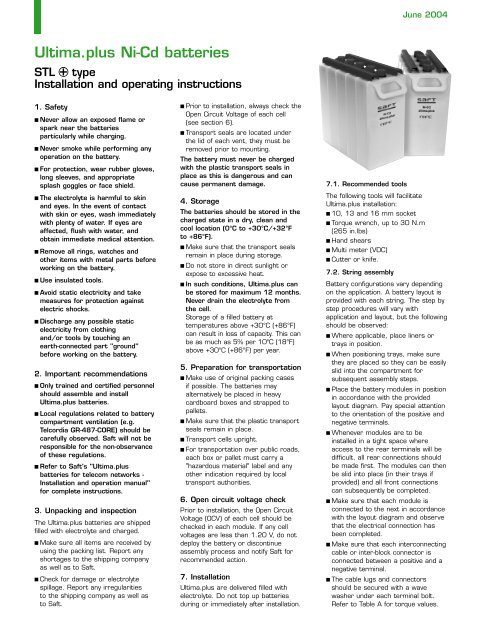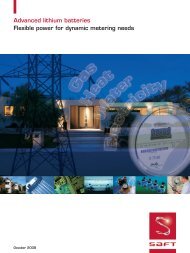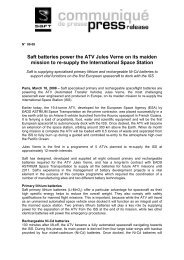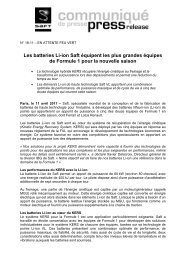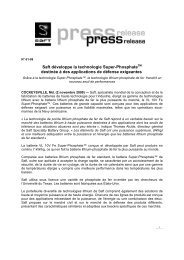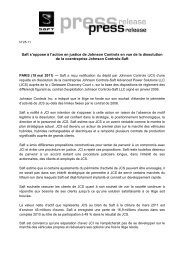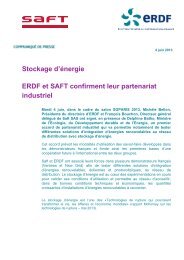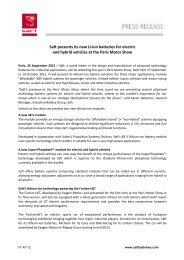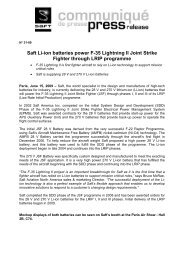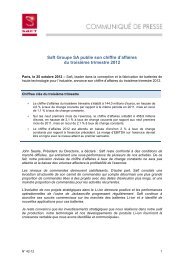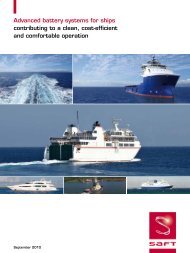Ultima.plus Ni-Cd batteries - Saft
Ultima.plus Ni-Cd batteries - Saft
Ultima.plus Ni-Cd batteries - Saft
Create successful ePaper yourself
Turn your PDF publications into a flip-book with our unique Google optimized e-Paper software.
<strong>Ultima</strong>.<strong>plus</strong> <strong>Ni</strong>-<strong>Cd</strong> <strong>batteries</strong><br />
STL + type<br />
Installation and operating instructions<br />
1. Safety<br />
■ Never allow an exposed flame or<br />
spark near the <strong>batteries</strong><br />
particularly while charging.<br />
■ Never smoke while performing any<br />
operation on the battery.<br />
■ For protection, wear rubber gloves,<br />
long sleeves, and appropriate<br />
splash goggles or face shield.<br />
■ The electrolyte is harmful to skin<br />
and eyes. In the event of contact<br />
with skin or eyes, wash immediately<br />
with plenty of water. If eyes are<br />
affected, flush with water, and<br />
obtain immediate medical attention.<br />
■ Remove all rings, watches and<br />
other items with metal parts before<br />
working on the battery.<br />
■ Use insulated tools.<br />
■ Avoid static electricity and take<br />
measures for protection against<br />
electric shocks.<br />
■ Discharge any possible static<br />
electricity from clothing<br />
and/or tools by touching an<br />
earth-connected part "ground"<br />
before working on the battery.<br />
2. Important recommendations<br />
■ Only trained and certified personnel<br />
should assemble and install<br />
<strong>Ultima</strong>.<strong>plus</strong> <strong>batteries</strong>.<br />
■ Local regulations related to battery<br />
compartment ventilation (e.g.<br />
Telcordia GR-487-CORE) should be<br />
carefully observed. <strong>Saft</strong> will not be<br />
responsible for the non-observance<br />
of these regulations.<br />
■ Refer to <strong>Saft</strong>'s "<strong>Ultima</strong>.<strong>plus</strong><br />
<strong>batteries</strong> for telecom networks -<br />
Installation and operation manual"<br />
for complete instructions.<br />
3. Unpacking and inspection<br />
The <strong>Ultima</strong>.<strong>plus</strong> <strong>batteries</strong> are shipped<br />
filled with electrolyte and charged.<br />
■ Make sure all items are received by<br />
using the packing list. Report any<br />
shortages to the shipping company<br />
as well as to <strong>Saft</strong>.<br />
■ Check for damage or electrolyte<br />
spillage. Report any irregularities<br />
to the shipping company as well as<br />
to <strong>Saft</strong>.<br />
■ Prior to installation, always check the<br />
Open Circuit Voltage of each cell<br />
(see section 6).<br />
■ Transport seals are located under<br />
the lid of each vent, they must be<br />
removed prior to mounting.<br />
The battery must never be charged<br />
with the plastic transport seals in<br />
place as this is dangerous and can<br />
cause permanent damage.<br />
4. Storage<br />
The <strong>batteries</strong> should be stored in the<br />
charged state in a dry, clean and<br />
cool location (0°C to +30°C/+32°F<br />
to +86°F).<br />
■ Make sure that the transport seals<br />
remain in place during storage.<br />
■ Do not store in direct sunlight or<br />
expose to excessive heat.<br />
■ In such conditions, <strong>Ultima</strong>.<strong>plus</strong> can<br />
be stored for maximum 12 months.<br />
Never drain the electrolyte from<br />
the cell.<br />
Storage of a filled battery at<br />
temperatures above +30°C (+86°F)<br />
can result in loss of capacity. This can<br />
be as much as 5% per 10°C (18°F)<br />
above +30°C (+86°F) per year.<br />
5. Preparation for transportation<br />
■ Make use of original packing cases<br />
if possible. The <strong>batteries</strong> may<br />
alternatively be placed in heavy<br />
cardboard boxes and strapped to<br />
pallets.<br />
■ Make sure that the plastic transport<br />
seals remain in place.<br />
■ Transport cells upright.<br />
■ For transportation over public roads,<br />
each box or pallet must carry a<br />
"hazardous material" label and any<br />
other indication required by local<br />
transport authorities.<br />
6. Open circuit voltage check<br />
Prior to installation, the Open Circuit<br />
Voltage (OCV) of each cell should be<br />
checked in each module. If any cell<br />
voltages are less than 1.20 V, do not<br />
deploy the battery or discontinue<br />
assembly process and notify <strong>Saft</strong> for<br />
recommended action.<br />
7. Installation<br />
<strong>Ultima</strong>.<strong>plus</strong> are delivered filled with<br />
electrolyte. Do not top up <strong>batteries</strong><br />
during or immediately after installation.<br />
June 2004<br />
7.1. Recommended tools<br />
The following tools will facilitate<br />
<strong>Ultima</strong>.<strong>plus</strong> installation:<br />
■ 10, 13 and 16 mm socket<br />
■ Torque wrench, up to 30 N.m<br />
(265 in.lbs)<br />
■ Hand shears<br />
■ Multi meter (VDC)<br />
■ Cutter or knife.<br />
7.2. String assembly<br />
Battery configurations vary depending<br />
on the application. A battery layout is<br />
provided with each string. The step by<br />
step procedures will vary with<br />
application and layout, but the following<br />
should be observed:<br />
■ Where applicable, place liners or<br />
trays in position.<br />
■ When positioning trays, make sure<br />
they are placed so they can be easily<br />
slid into the compartment for<br />
subsequent assembly steps.<br />
■ Place the battery modules in position<br />
in accordance with the provided<br />
layout diagram. Pay special attention<br />
to the orientation of the positive and<br />
negative terminals.<br />
■ Whenever modules are to be<br />
installed in a tight space where<br />
access to the rear terminals will be<br />
difficult, all rear connections should<br />
be made first. The modules can then<br />
be slid into place (in their trays if<br />
provided) and all front connections<br />
can subsequently be completed.<br />
■ Make sure that each module is<br />
connected to the next in accordance<br />
with the layout diagram and observe<br />
that the electrical connection has<br />
been completed.<br />
■ Make sure that each interconnecting<br />
cable or inter-block connector is<br />
connected between a positive and a<br />
negative terminal.<br />
■ The cable lugs and connectors<br />
should be secured with a wave<br />
washer under each terminal bolt.<br />
Refer to Table A for torque values.
<strong>Ultima</strong>.<strong>plus</strong> <strong>Ni</strong>-<strong>Cd</strong> <strong>batteries</strong><br />
Table A (Terminal size and torque value):<br />
Terminal size M6 M8 M10<br />
Socket 10 mm 13 mm 16 mm<br />
Torque 11 N.m (97 in.lbs) 20 N.m (177 in.lbs) 30 N.m (265 in.lbs)<br />
■ If a central water filling system is<br />
used as an option, refer to the<br />
corresponding installation and<br />
operating instructions sheet.<br />
■ Apply anti-corrosion oil on both<br />
terminals of each module as well as<br />
on both extremities of the connecting<br />
wires.<br />
■ If necessary, trim and cut covers with<br />
a knife. Place covers over inter-cell<br />
links by snapping them into position.<br />
■ Do not at this stage connect the<br />
system’s power cables.<br />
7.3. Connecting power<br />
■ Before connecting the power cables<br />
to the string, measure the string as<br />
well as each module’s Open Circuit<br />
Voltage (OCV). It must be higher<br />
than 1.20 V x the number cells<br />
(i.e 45.6 V for a 38 cell string).<br />
■ Temperature compensated voltage<br />
control is recommended<br />
(see section 9).<br />
■ Make sure the output of the rectifier<br />
is adjusted to: 1.43 V per cell<br />
i.e V = 54.4 for 38 cells at +20°C<br />
to +25°C (+68°F to +77°F).<br />
■ Note the polarity of the battery<br />
terminals and verify the polarity of<br />
the power cables before connecting<br />
these to the battery. Look for polarity<br />
markings. DO NOT rely on colour<br />
matching.<br />
■ Connect the power cables (–) and (+)<br />
to the string terminals and secure<br />
hardware: Refer to table 7.3. for<br />
torque values.<br />
■ Apply approved corrosion<br />
preventative compound on string<br />
terminals.<br />
■ Apply rectifier power to the power<br />
cables by closing string breakers or<br />
turning the rectifiers on.<br />
<strong>Saft</strong><br />
Industrial Battery Group<br />
12, rue Sadi Carnot<br />
93170 Bagnolet - France<br />
Tel: +33 1 49 93 19 18<br />
Fax: +33 1 49 93 19 64<br />
www.saft<strong>batteries</strong>.com<br />
STL + 38 STL + 77 STL + 115 to STL + 460<br />
8. Commissioning<br />
If <strong>Ultima</strong>.<strong>plus</strong> <strong>batteries</strong> are stored<br />
more than 6 months and up to 1 year,<br />
a commissioning charge is necessary<br />
and use one of the methods below:<br />
■ Constant current charge:<br />
16 h at 0.1 C8 A maximum.<br />
■ Constant potential charge:<br />
1.65 V/cell for a maximum of 30 h<br />
with current limited to 0.1 C8 A.<br />
If these methods are not available,<br />
then charging may be carried out<br />
at a lower voltage of 1.50 V/cell for<br />
72 hours minimum. Current limited<br />
at 0.1 C8 A.<br />
9. Charging<br />
■ Constant voltage charging is<br />
recommended and should be done<br />
at 1.43 V per cell (54.4 ± 0.7 V per<br />
38 cells string) at +20°C to +25°C<br />
(+68°F to +77°F).<br />
■ For use at temperatures outside the<br />
range of +15°C to +25°C (+59°F to<br />
+77°F), a temperature compensation<br />
on the charge voltage is<br />
recommended to further optimize<br />
the topping-up intervals at high<br />
temperatures. The recommended<br />
value is:<br />
– 2.5 mV/°C/cell (– 1.4 mV/°F/cell).<br />
10. Maintenance and inspection<br />
10.1. Watering<br />
Watering should be done in average<br />
once every 5 years when temperature<br />
compensation is used. Never let the<br />
electrolyte level fall below the plate top.<br />
Use only distilled or deionized water to<br />
top-up. Refer to the instruction sheet<br />
provided by <strong>Saft</strong>’s watering kit.<br />
Doc N° 21520.2 - 0604<br />
Data in this document is subject to change without<br />
notice and becomes contractual only after written<br />
confirmation.<br />
Société anonyme au capital de 31 944 000 €<br />
RCS Bobigny B 383 703 873<br />
Pragma - Printed in France - 1k<br />
The maximum quantity of distilled<br />
water to be added is tabulated below:<br />
Table B (maximum quantity of<br />
distilled water to be added):<br />
Maximum quantity of water<br />
Type per cell for a 38 cells string<br />
(cc) (l) (US gal)<br />
STL � 38 190 7.5 1.98<br />
STL � 77 280 11.0 2.90<br />
STL � 115 380 14.5 3.83<br />
STL � 155 500 19.0 5.02<br />
STL � 190 590 22.5 5.94<br />
STL � 230 700 27.0 7.13<br />
STL � 270 860 33.0 8.72<br />
STL � 305 1000 38.0 10.04<br />
STL � 345 1100 42.0 11.10<br />
STL � 385 1200 46.0 12.15<br />
STL � 460 1400 53.5 14.13<br />
10.2. Cleaning<br />
It is good practice to visually inspect<br />
the string periodically. Vacuuming or<br />
dusting with a soft brush is adequate if<br />
the string is dirty. A wet rag may be<br />
used, but do not use any detergent,<br />
chemicals or cleaning aids. Do not use<br />
metal brushes or hard bristles.<br />
10.3. Inspection and control<br />
Check the float voltage and adjust as<br />
necessary within the acceptable range<br />
(see §9). Re-torquing terminal bolts is<br />
not recommended.<br />
11. Removal and recycling<br />
To protect the environment all used<br />
<strong>batteries</strong> must be recycled.<br />
Contact your local <strong>Saft</strong> representative<br />
for further information.


